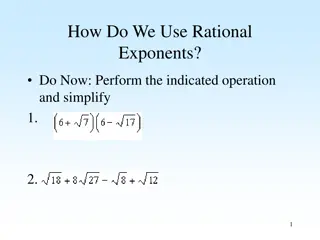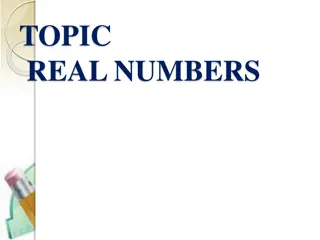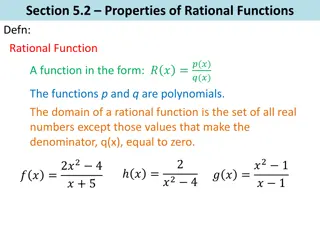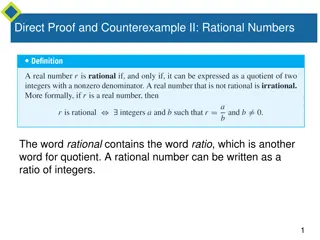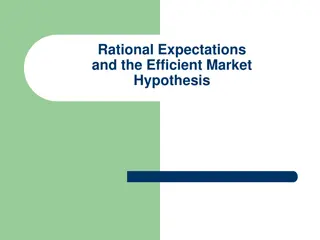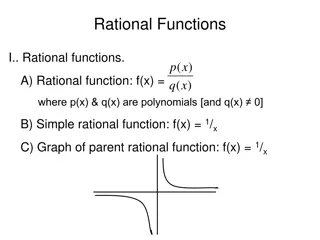
Polynomial and Synthetic Division Techniques Explained
Learn how to use long division and synthetic division to divide polynomials by other polynomials. Understand the Remainder Theorem and the Factor Theorem to solve polynomial division problems efficiently.
Download Presentation

Please find below an Image/Link to download the presentation.
The content on the website is provided AS IS for your information and personal use only. It may not be sold, licensed, or shared on other websites without obtaining consent from the author. If you encounter any issues during the download, it is possible that the publisher has removed the file from their server.
You are allowed to download the files provided on this website for personal or commercial use, subject to the condition that they are used lawfully. All files are the property of their respective owners.
The content on the website is provided AS IS for your information and personal use only. It may not be sold, licensed, or shared on other websites without obtaining consent from the author.
E N D
Presentation Transcript
Polynomial and Synthetic Division
What you should learn How to use long division to divide polynomials by other polynomials How to use synthetic division to divide polynomials by binomials of the form (x k) How to use the Remainder Theorem and the Factor Theorem
1. Long Division. 1. x goes into x3? x2 times. 2. Multiply (x 1) by x2. 3. Change sign, Add. + + 2 x 2 6 x + + + 3 2 1 4 6 x x x x x x x x 4. Bring down 4x. 3 3 2 2 5. x goes into 2x2? 2xtimes. 6. Multiply (x 1) by 2x. 7. Change sign, Add + + + 2 4 2 2 x x x 0 2 2 x 2 2 x 0 + 2 x 8. Bring down 6. 9. x goes into 6x? 10. Multiply (x 1) by 6. 6times. + 6 6 6 6 6 0 x x x 6 11. Change sign, Add.
2. Long Division. x + 5 + + + 2 3 8 3 3 15 x x x x x x x 2+ 2 Check + + ( 3 )( 5 ) 5 3 x x x 5 + x 5 + x 5 x 15 15 0 15 = = + + + + + 2 15 x x 2 8 15 x x
+ + 3x 9 2x 3. Long Division. + + + 3 2 3 0 3 3 3 3 3 0 27 x x x x x x x x x x x 3 3 2 2 3 27 3 x + + 2 0 9 9 9 9 9 x x x x x x x 2 2 27 27 27 0 3 3 27 x x +
4. Long Division. x + 2 + 2 4 2 4 4 8 x x x x x x x 2 2 Check + 2 ( 2 )( 4 ) 4 2 x x x 2 x 2 x 2 x 8 8 0 + 8 = = + 8 x x 2 2 8 x x
5. Long Division. 2 + p + + 2 44 + 20 p p = p +p 4 6 6 + + + 2 6 2 6 20 p p p p p 2 2+ p 6 p Check 44 p + + + + + + 4 4 4 20 24 44 ( 6 )( ) 4 ( ) 6 p p p p p p + 6 24 = + + 2 4 6 24 44 p p p = + + 2 2 20 p p
Review Long Division. x + 2 + 2 4 2 4 4 8 x x x x x x x 2 2 Check + 2 ( 2 )( 4 ) 4 2 x x x 2 x 2 x 2 x 8 8 0 + 8 = = + 8 x x 2 2 8 x x
Synthetic Division - divide a polynomial by a polynomial To use synthetic division: There must be a coefficient for every possible power of the variable. The divisor must have a leading coefficient of 1. ( ( ) ) 6: + + + + 4 2 Ex x x x x 5 4 6 ( 3)
( ( ) ) 6 + + + + 4 2 x x x x 5 4 ( 3) Step #1: Write the terms of the polynomial so the degrees are in descending order. 5x4+ 0x3 4x2+x +6 Since the numerator does not contain all the powers of x, you must include a 0 for thex3.
( ( ) ) 6 + + + + 4 2 x x x x 5 4 ( 3) Step #2: Write the constant r of the divisor x-r to the left and write down the coefficients. 5x4+ 0x3 4x2+x +6 3 -4 6 1 5 0 Since the divisor is x-3, r=3
( ( ) ) + + + + 4 2 x x x x 5 4 6 ( 3) Step #3: Bring down the first coefficient, 5. 3 5 0 -4 1 6 5
( ( ) ) 6 4 2 + + + + x x x x 5 4 ( 3) Step #4: Multiply the first coefficient by r, so 3 5 and place under the second coefficient then add. = = 15 3 5 0 -4 1 6 15 15 5
( ( ) ) 6 4 2 + + + + x x x x 5 4 ( 3) Step #5: Repeat process multiplying the sum, 15, by r; and place this number under the next coefficient, then add. = = 15 3 45 3 5 0 -4 1 6 15 45 41 15 5
( ( ) ) 6 4 2 + + + + x x x x 5 4 ( 3) Step #5 cont.: Repeat the same procedure. Where did 123 and 372 come from? 3 5 0 -4 1 6 15 45 41 123 124 372 378 15 5
( ( ) ) 6 4 2 + + + + x x x x 5 4 ( 3) Step #6: Write the quotient. The numbers along the bottom are coefficients of the power of x in descending order, starting with the power that is one less than that of the dividend. 3 5 0 -4 1 6 15 45 41 123 124 372 378 15 5
( ( ) ) 6 4 2 + + + + x x x x 5 4 ( 3) The quotient is: 5x3+15x2+ 41x +124 +378 x 3 Remember to place the remainder over the divisor.
7. Synthetic Division Divide (x4 10x2 2x + 4) by (x + 3) 1 0 -10 -2 4 3 3 +9 3 3 1 1 1 1 3 ) 3 + 4 2 1 + ( 10 2 ) 4 x x x + 3 2 +x = 3 1 x x x + ( x 3
+ x 1 8. Synthetic and Long Division 2 3 2 3 3 8 x x x x x x x 1 2 8 3 2 2+ 3 3 8 3 5 x x 5 1 1 x + 3 = = = = 2 2 ( ) 2 8 f x x x ) 3 ( f ) 3 ( 9 ) 3 ( 2 8 8 5 6
The Remainder Theorem If a polynomial f(x) is divided by (x k), the remainder is r = f(k). x + 1 2 3 2 3 3 8 x x x x x x x = = = = 2 2 ( ) 2 8 f x x x 2 2+ ) 3 ( f ) 3 ( 9 ) 3 ( 2 8 8 5 8 3 5 x x 6 x + 3
The Factor Theorem A polynomial f(x) has a factor (x-k) if and only if f(k)=0. Show that (x-2) is a factor of: ? ? = 2?4+ 7?3 4?2 27? 18 ? 2 = 2(2)4+7(2)3 4(2)2 27 2 18 ? 2 = 32 + 56 16 54 18 ? 2 = 0 2 7 4 27 18 +2 4 22 18 36 9 0 2 11 18
Uses of the Remainder in Synthetic Division The remainder r, obtained in synthetic division of f(x) by (x k), provides the following information. 1. r = f(k) 2. If r = 0 then (x k) is a factor of f(x). 3. If r = 0 then (k, 0) is an x intercept of the graph of f.


